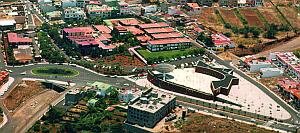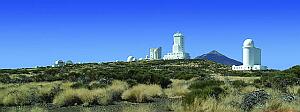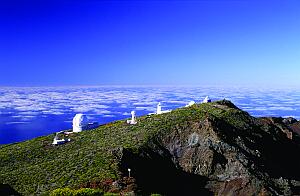IAC Partnership with ING
Francisco Sánchez Martínez (Director IAC)
The Instituto de Astrofísica de Canarias (IAC) opened its observatories
to the international scientific community in 1979, as a result of the Agreement
on Co-operation in Astrophysics. Ever since, its vocation has been to serve
as more than a mere venue for telescopes and instruments from different countries.
It has gradually become involved in new telescopes and it has strengthened
its bonds of co-operation with the user institutions.
The Isaac Newton Group of Telescopes, pioneer in astronomical observations
at the Roque de los Muchachos Observatory, is one of the most complete and
advanced collections of optical/infrared telescopes in Europe. For over 20
years, these telescopes have given the British, Dutch and Spanish scientific
communities the chance to make state-of-the-art observations, which have
made a tremendous contribution to pushing back the frontiers of knowledge
in many fields of astronomy. Discovery of the optical counterparts of gamma
ray bursts, studies of galaxy formation and the search for and characterisation
of brown dwarfs are but a few of many examples we could mention.

|

|

|
From top to bottom: IAC in La Laguna
(Tenerife) [ JPEG | TIFF ],
Observatorio del Teide (Tenerife) [ JPEG | TIFF ] and Observatorio del Roque de Los Muchachos (La
Palma) [ JPEG | TIFF ]. Both
observatories are operated by the IAC.
|
The vital role these telescopes have played in the development of Spanish
astronomy is beyond doubt. Their value can be seen from the fact that many
more observing proposals are submitted to the WHT and INT than can be carried
out. On the WHT, four out of five good observing proposals from Spanish groups
cannot be carried out due to lack of telescope time.
It is well-known that optimum use of 10-m telescopes requires medium-sized
telescopes (between 2 and 4 metres) to act as support and to prepare projects
to be carried out on larger diameter telescopes. With the imminent start
of operations of the Gran Telescopio de Canarias, the ING telescopes will
play an important role.
For this reason, PPARC’s decision to reduce the funding available for operating
the ING telescopes was a cause of deep concern for the IAC. In the face of
this uncertainty and concerned about the ING’s future, the IAC decided to
explore possible ways to reinforce co-operation with the ING to ensure its
continuity and to guarantee that its telescopes will continue to operate
in optimum conditions.
The agreement with PPARC and NWO has ensured operational continuity of the
ING, whilst, at the same time, providing additional time for Spanish astronomers.
The IAC contribution consists of qualified staff, astronomers and engineers,
plus an infrared imaging spectrograph for the WHT (LIRIS). The overall IAC
contribution is equivalent to about half a million euros per year. The Spanish
astronomy community increases its share of ING telescope time by 9.1% a year.
In particular, this time is being used to prepare the science that will be
done with the GTC.
Because drafting of the legal texts of agreements between institutions of
several different countries is seldom easy, formal signing of the agreement
has been delayed. This, however, has not prevented the agreement from being
applied. Since 2002, observing time has been made available and IAC staff
have gradually joined ING telescope activities. Furthermore, the first commissioning
of the LIRIS instrument was highly successful, far exceeding the expectations
of both the ING and the IAC.
Spanish astrophysicists have already benefited from the increased access
to time on these telescopes, with a start being made on several programmes
that were approved after the relevant announcement of opportunity was made
to the entire Spanish astronomical community.
We are sure that this agreement will help to reinforce co-operation among
our institutions, thus facilitating increased collaboration in the future
within the “European Research Area” that the European Union is promoting.
We are convinced that this will strengthen astronomy on La Palma, where the
exceptional natural conditions will continue to be attractive for the installation
of new generation telescopes. This will have a direct impact on European
astronomy, particularly if the European Extremely Large Telescope is finally
installed at the Roque de los Muchachos Observatory in the next decade.
¤
Email contact: Francisco
Sánchez (
director@ll.iac.es)





